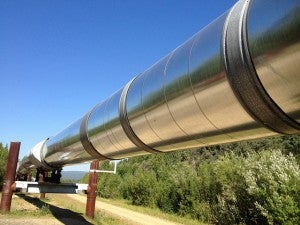Reducing Carbon Pollution From The Power Sector Without Building Thousands Of Miles Of New Pipelines
 With the Environmental Protection Agency’s proposed Clean Power Plan to reduce carbon pollution from the nation’s power plants nearing finalization, all sides are looking closely at the capacity of our existing infrastructure to deliver emission reductions from the power sector — including the natural gas infrastructure that could help reduce the need for aging, carbon-intensive coal-fired generation.
With the Environmental Protection Agency’s proposed Clean Power Plan to reduce carbon pollution from the nation’s power plants nearing finalization, all sides are looking closely at the capacity of our existing infrastructure to deliver emission reductions from the power sector — including the natural gas infrastructure that could help reduce the need for aging, carbon-intensive coal-fired generation.
Some opponents of the Clean Power Plan say we need to invest billions of dollars in thousands of miles of new pipelines, while environmentalists, clean energy advocates and others are concerned that investments in new pipelines serves to reinforce fossil fuel dependence.
What policymakers and regulators need to know is this: Right now, 46 percent of the pipeline capacity that already exists isn’t being used, according to a recent study by the U.S. Department of Energy.
Yes, 46 percent.
Figures like this mean everybody needs to rethink the whole infrastructure equation, and how to balance it most effectively.
Eat What’s On Your Plate Before You Ask for More
In remarks before the five Commissioners on the Federal Energy Regulatory Commission (FERC) recently, I described how the extensive natural gas pipeline system that’s already in place in the United States today can help address the use of natural gas anticipated under EPA’s proposed Clean Power Plan.
The discussion was part of a FERC technical conference assessing implications of the Clean Power Plan on electric reliability, energy markets and infrastructure including natural gas pipelines and electric transmission. The plan sets forth state-wide targets for reducing carbon pollution from existing power plants through 2030, based on cost-effective and proven means for reducing emissions from the power sector including increased energy efficiency, renewable energy deployment, and increasing the amount of electricity produced by natural gas-fired power plants. (States also have broad flexibility if they choose to craft individualized plans to meet those targets deploying a wide variety of solutions.)
The Keys to Unlock Existing Pipeline Capacity
At the FERC conference, EDF recommended a series of actions FERC could take in short order to optimize our utilization of the existing infrastructure and avoid building unnecessary natural gas pipelines. These steps are readily achievable because they entail relatively minor refinements to the natural gas wholesale market design that would increase coordination between the gas and electric industries so that the needs of power generators are better served by pipeline operators.
First and foremost, FERC should require pipeline operators to increase the frequency and number of daily opportunities for their customers – power plants – to reserve space on the pipes and schedule deliveries. These are called “nominating cycles,” and FERC’s rules require pipelines to provide at least two per day. In practice, however, a few pipeline operators have largely automated their scheduling systems and allow customers to submit scheduling requests as many as 24 times per day.
This is important because it allows power generators to schedule gas deliveries on short notice in response to real time conditions on the grid and reliability needs. EDF recently submitted comments to FERC with data analyzing pipeline utilization during the polar vortex events of 2014 which demonstrates that pipelines that provide more nominating cycles are used to a far greater extent of their maximum capacity than those which only provide the minimum requirement of two per day.
Adding Flexibility Around the Clock
EDF also urged the Commission to require pipelines to allow power plants to schedule varying flows and quantities over the course of a day. Currently, many pipelines provide very little flexibility in the amount of gas a customer may seek to have delivered, frequently requiring that deliveries be for a fixed quantity of gas divided evenly over 24 hours. In industry parlance, this is referred to as “ratable” flow.
Electricity demand ramps up significantly in the morning, and down at night. Add to that increasing amounts of low-cost, but variable, supplies of wind and solar energy, and it’s easy to see why power plants – which will increasingly provide grid “firming” or “balancing” services to maintain reliability – need more flexibility in natural gas supplies to meet frequently changing demand for electricity.
Unfortunately, operators are stuck with obsolete ratable flow requirements left over from years ago, before flexible gas-fired power plants became a major customer of the pipelines. That means the current gas market is less responsive than it can and should be in order to efficiently serve gas-fired electric generators. It also means we’re not getting as much use as we could be out of our existing pipeline infrastructure.
Keeping Up With the Times
As more renewable resources, distributed generation and demand response capability is added to the grid, it will be ever more critical to optimize a more dynamic pipeline system. With well-designed market reforms, the existing interstate pipeline system can meet the needs created by the innovative new products, services and technologies being added to the electric system it feeds.
Photo source: Flickr/Maureen










